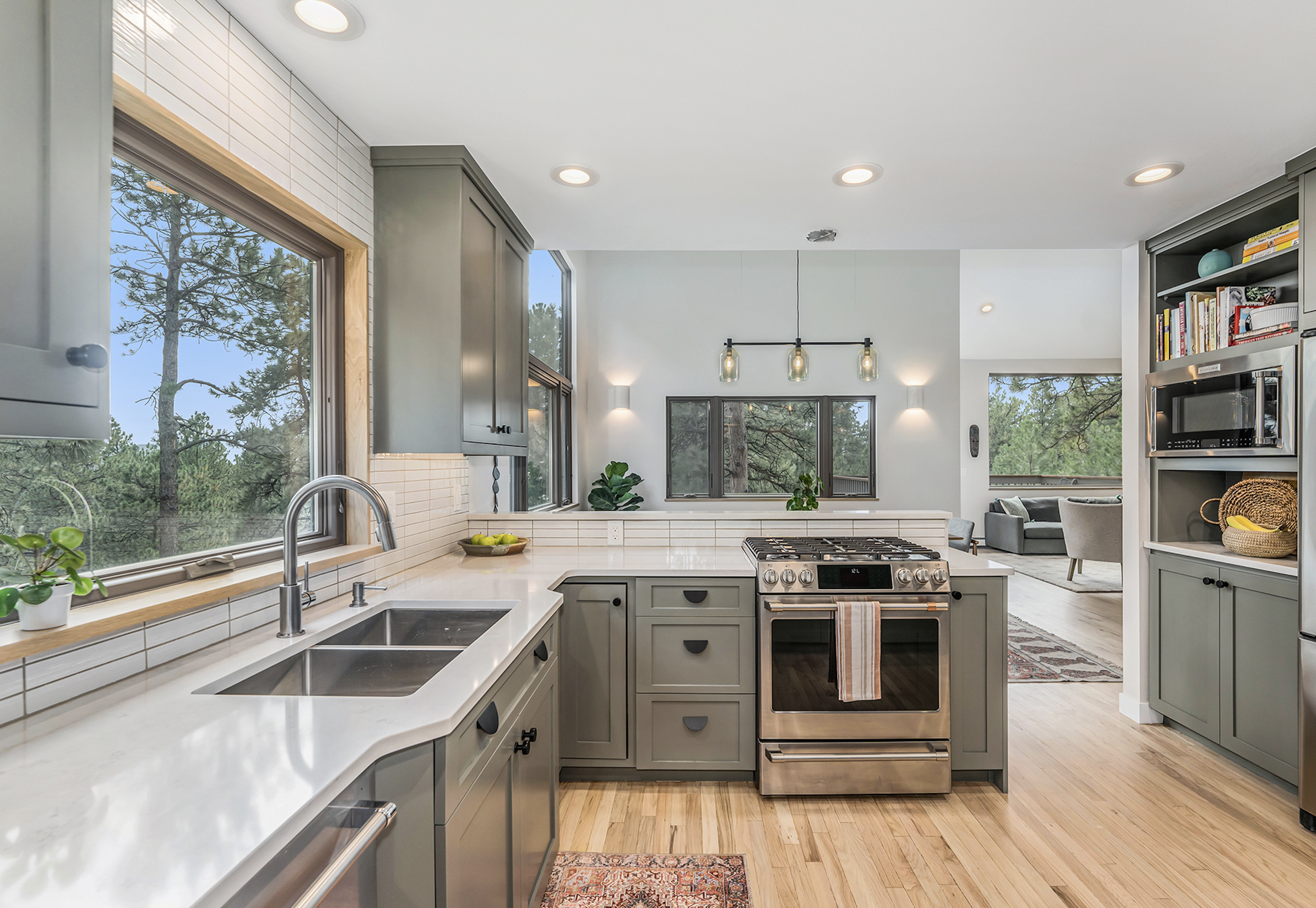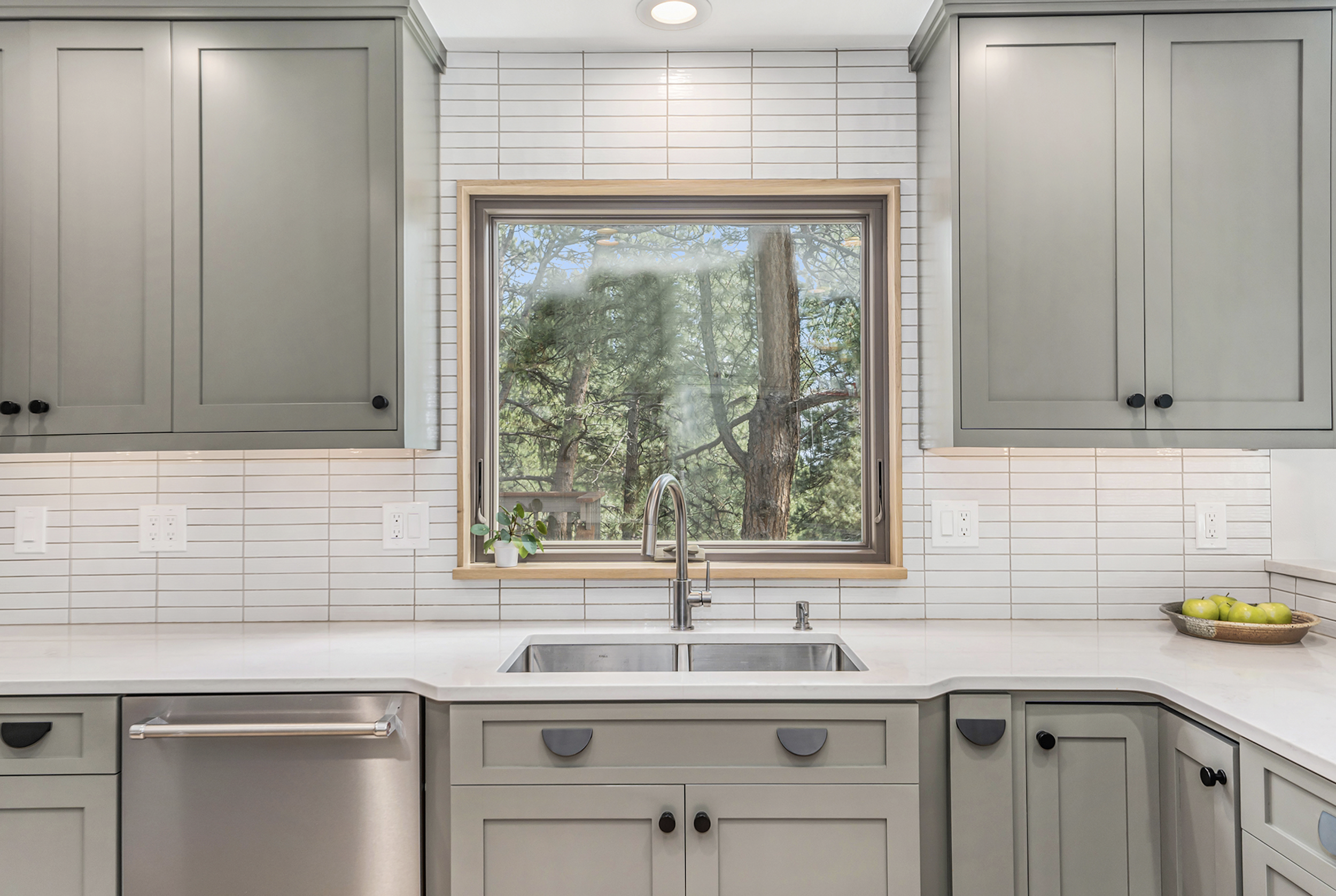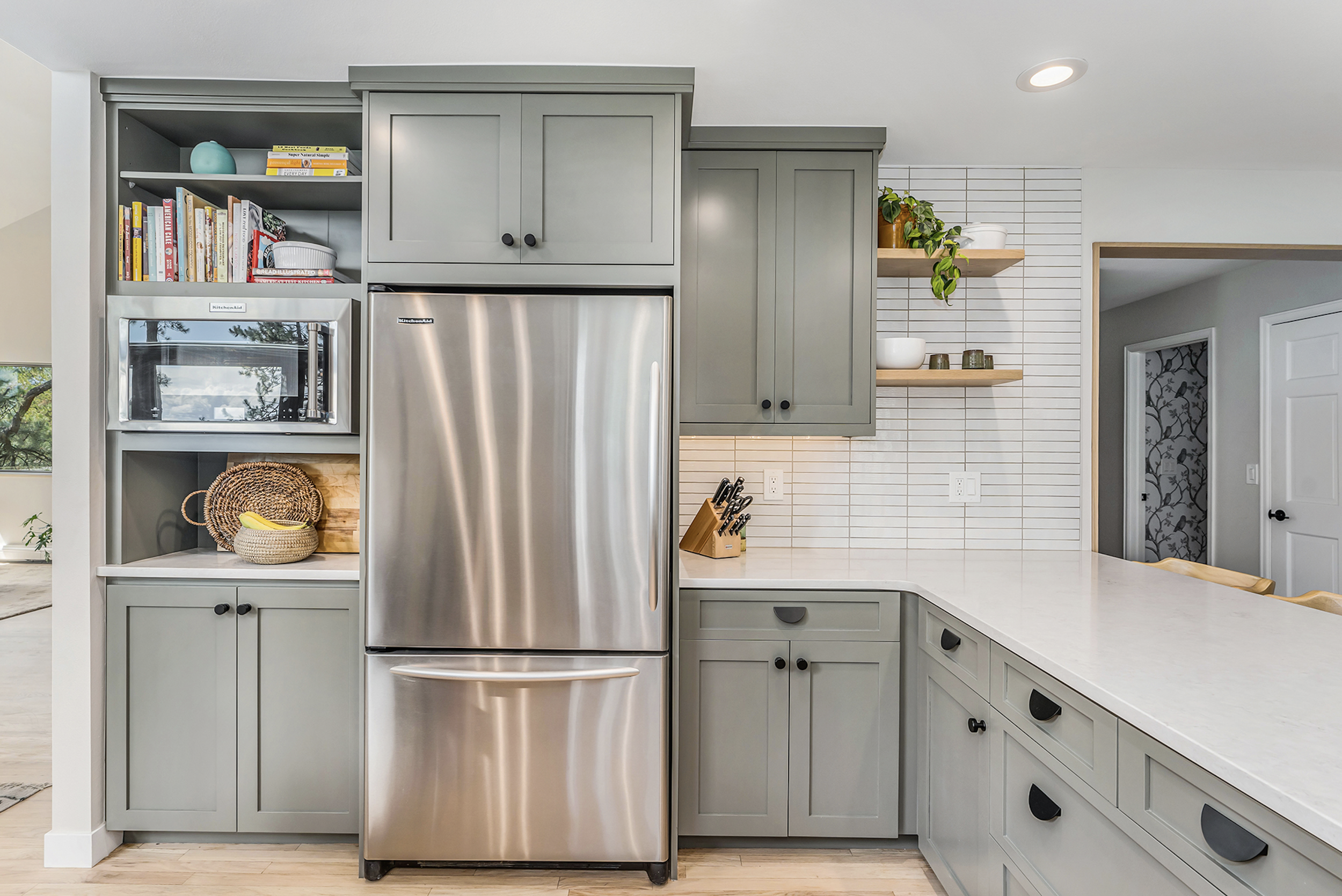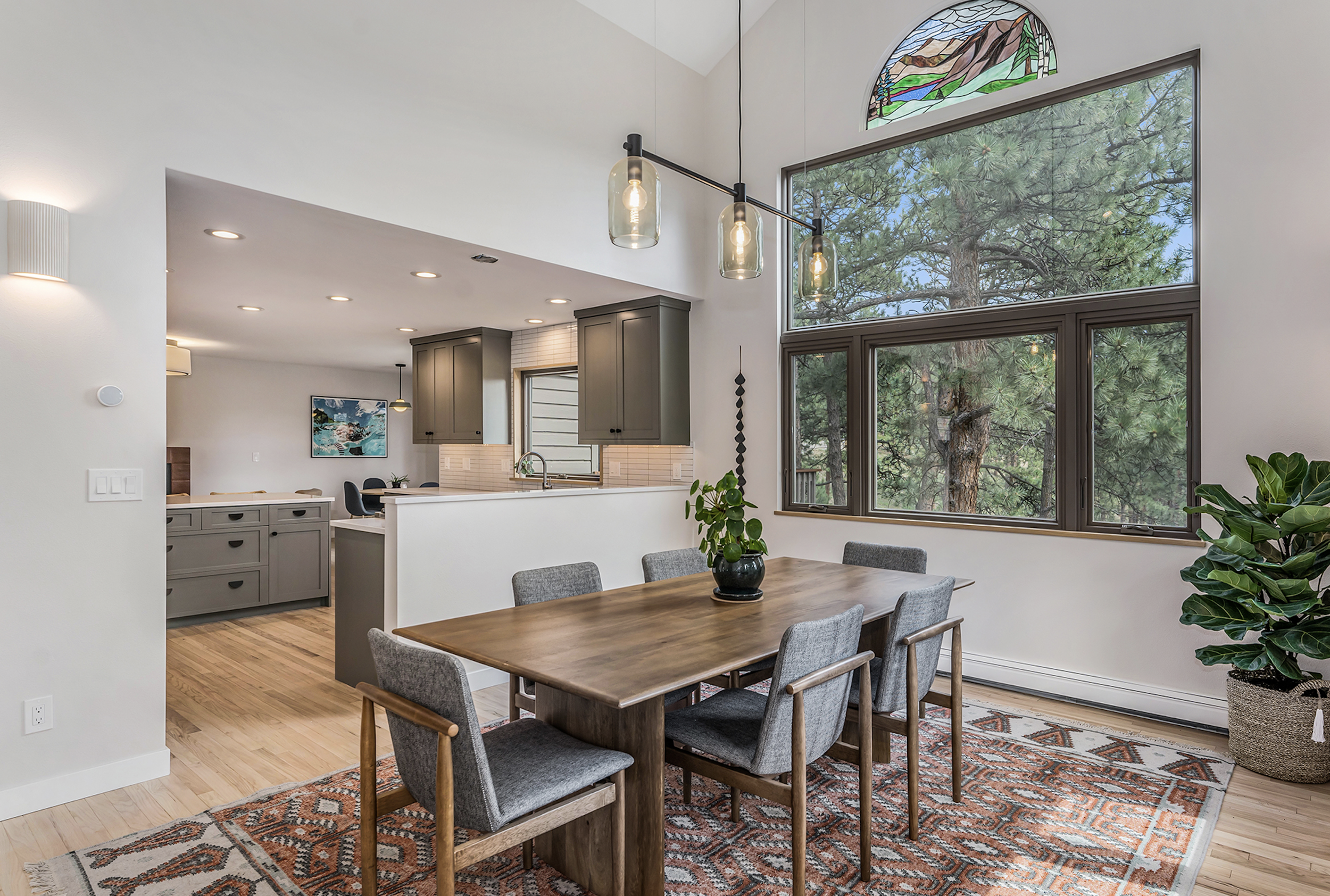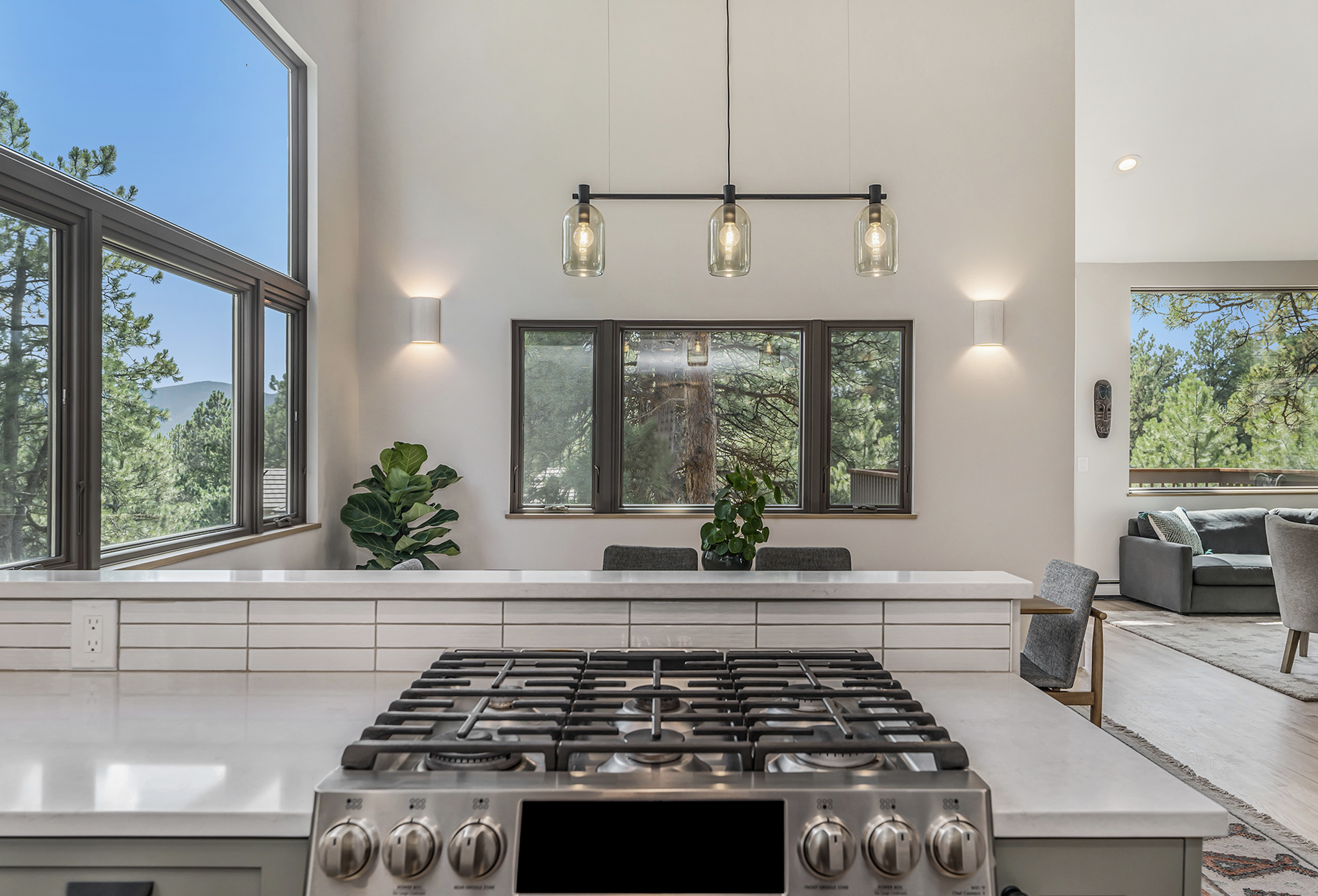If there is a home that you would like more information about, if you are considering selling a property, or if you have questions about the housing market in your neighborhood, please reach out. We’re here to help.
As Featured in West + Main Home Magazine: A mountain kitchen with modern chalet style
“We moved into this home in July 2021, and the kitchen felt closed off, dark, and just not our style,” said West + Main agent and homeowner Julie Lunn. “It felt too brown and rustic, and we wanted more natural light and re-flectivity in this space as well as more contemporary finishes. The dining room was also closed off and terribly outdated, with huge valances over the windows, wing walls separating the dining space from the living room, and some chair rail details that just weren’t working. Lucky for me, my husband Eric is a general contractor and masterful framer/carpenter, so he came up with a plan to support opening up the wall from the kitchen to the dining space, which then flooded the kitchen with light. The dining area walls were non-structural and 15 feet tall, so they were just a large demo project!”
"We wanted to keep as much as of the existing materials/appliances as we could but make it our style which we feel is more clean, modern + warm, white + wood, clean lines + organic touches," said Julie. "For this project I called it Modern Chalet. We are also both from Minnesota originally so are heavily influenced by Scandinavian design."
“Being in a mountain environment, it didn’t make sense to go too starkly modern. That said, we just aren’t really into a cabin or super woodsy/rustic feel either.” said Julie. “Our goal was to update the space but make it feel right in this casual but gorgeous natural backdrop. And because we don’t know if we’ll stay in this home forever, we hope we created a look that is at least somewhat appealing to others in case we decide to sell!”
"At first we considered lighter cabinets with a darker countertop but eventually landed on a beautiful earthy green cabinet paint topped with light quartz countertops and a slightly organic white ceramic tile for our backsplash," said Julie. "The cabinet paint color is one that you would never have picked just looking at the chip, but after trying many greens, this one felt the most grounded and chameleon-like based on the light in the space. It was important to us that we wouldn’t get sick of it and that it had some neutrality in its tones, so we chose a green that is less bold than some of the current trends."
“I firmly believe that your space needs to reflect your style and that when you feel totally at home you have more energy to bring your best self to your family, life and work,” said Julie. “What I love the most is that I feel totally at home in the space now – not like I’m staying at my great aunt’s house, as nice as it was. I also love the light that we get throughout the day. My favorite finish detail is the modern white oak trim Eric put around the window and how the white tile joins up with it perfectly. I admire it while I do the dishes!”
Materials and sourcing
New cabinet paint: Sherwin Williams Thunderous 6201
Cabinet hardware: CB2
Countertops: Nustone Belford quartz
Backsplash tile: Daltile: Cepac tile
Dining room light: bludot
Related Links
If there is a home that you would like more information about, if you are considering selling a property, or if you have questions about the housing market in your neighborhood, please reach out. We’re here to help.
Are Gallery Walls Over?
Curated framed art and photos are under TikTok scrutiny as designers debate whether the gallery wall should retire for good.
“So bad,” reads one comment below a TikTok declaring 2010s gallery walls over. “I feel attacked!” reads another. “It’s us girls who used to make magazine collages for our binders that started this…and I’m still here for it!” reads yet one more. It seems the gallery wall—a cluster of art or decorative items strategically hung on a wall—has become almost as divisive as wood paneling and shag carpet. For fear of carrying on with an outdated trend we must ask AD’s interior design friends: Are gallery walls out of style?
“Never!” declares Mary Patton, owner and designer at Mary Patton Design in Houston, without hesitation. Though Clara Jung of Banner Day Interiors in the Bay Area gives a much more tempered response: “I don’t necessarily think so,” she says. “However, I think they should be executed thoughtfully and with intention.” Meanwhile, Molly Torres Portnof of Date Interiors in New York points out that gallery walls can’t go out of style as they’re timeless (yes, going back even further than 2010) and more than a passing fad. “They’ve survived hundreds of years of fluctuating design trends and for good reason: A wall full of art brings color, character, depth, and style to any space,” she says.
So how did we get here, to the 21st-century interpretation (or misinterpretation, depending on who you ask) of gallery walls? And how do we salvage them by curating collections with more intention, as Jung suggests? Let’s start from the beginning.
The history of gallery walls
“Gallery walls were first seen in France in the 1600s, when they were called salon walls,” Jung says. Salons, or cultural hubs, democratized art by ditching the old elite way of hanging a precious few pieces and instead filling entire floor-to-ceiling walls with works, primarily by up-and-coming artists. Salons soon opened to the public, making art more accessible to all social classes, and eventually spread to other countries, with art dealers and collectors adopting their frenzied arranging method.
Though public gallery walls afforded more access for ogling, it seems it was still only the elite who created the display at homes well into the 20th century, at least in the US. This was likely because only the wealthy had the cash to hire interior designers and hang up art in the first place. (Remember, Etsy prints weren’t a thing at this point.) But by the 1960s—the era of peace, love, and rocking a DIY salon wall—all that would change. A 1967 newspaper article titled “Gallery Wall Good Way to Display Pictures” was syndicated across the country, giving everyday homeowners (not just serious art collectors) tips on curating framed pieces.
In the ’80s and ’90s, gallery walls became all about family photos. Who hasn’t seen a home with a grouping of school portraits lining a staircase? Even more recently, 2013 was a hallmark year for the decorating scheme with another syndicated article, “Salon Walls Tell a Story,” hitting papers from coast to coast. This time homeowners were encouraged to hang “personal treasures” on their walls, including “exotic turtle shells, vintage medicine bottles, and colorful plates.” Since then it’s been a mixed bag, with design sites declaring one year “the year of the gallery wall” and another site asking in that very same year, “are gallery walls over?”
So where did our walls go wrong?
Were 2013’s turtle shells a touch too much? It’s clear that at some point a centuries-old tradition slid into the questionable collage territory that’s been called out on TikTok. In fact, the gallery walls that garner the most criticism are the ones that look like all the items were gathered in a single shopping trip, generic wood signs and all. As one TikTok commenter put it, “Ugh, it’s giving me craft store vibes.” And here lies the biggest gallery wall pitfall: rushing to make it happen. Fueled by the hype, some novice designers and DIY’ers may have been a bit too hasty to make it happen. To remedy slap-stick gallery walls that could cameo as decor in a dentist’s waiting area, approach your wall like a real collector.
Tips for creating a good gallery wall
1. Make it meaningful
“Biggest rule of thumb: Don’t ever hang anything on your wall that isn’t meaningful to you,” Torres Portnof says. “When salon walls were first popularized, the specific placement of each art piece was very purposeful and, in certain cases, pointed and political.” She suggests choosing pieces that are “grand, striking, or most significant” to anchor your gallery wall, then fill the surrounding space with other pieces.
2. Mix mediums
Keep in mind that significant doesn’t have to mean fine art (hello, turtle shells!). The designers AD spoke with encourage thinking outside the frame. “Do a mix of art, textiles, and baskets that you collect on your travels,” Patton adds. Or skip the art altogether and group like objects, as Brittany Farinas and her team at House of One Interior Design in Miami do. “Sometimes we’ll hang a group of vertical or square mirrors together on an accent wall by a window to make the space seem visually larger and to add interest to a space,” she says.
3. Go big
And if you’re worried a gallery wall will feel chaotic, steer clear of too many small pieces. “I would suggest playing with scale and going oversized,” Jung says. Four large paintings grouped together can cover an entire wall without overwhelming the gaze. Farinas echoes this by saying, “Grouping black and white oversized frames in an array can create visual interest and become an opportunity to play with scale in a space.” She also points out that tiny frames on a large wall look disproportionate.
Long live the gallery wall
A sigh of relief for salon supporters everywhere: According to the pros, the gallery wall will survive! Plus, if history has taught us anything, it won’t just survive but continue to evolve (are NFT gallery walls a thing?!). In the meantime, keep your art and photo displays going. “Keep in mind that gallery walls are meant to evolve and grow over time as you continue to collect and curate pieces,” Torres Portnof says. “Think of the walls in your home as your personal gallery, showcasing your cherished memories, favorite artists, family heirlooms, and travels.”
Read the full post on Architectural Digest.
Related Links
If there is a home that you would like more information about, if you are considering selling a property, or if you have questions about the housing market in your neighborhood, please reach out. We’re here to help.
Planning To Sell Your House? It’s Critical To Hire a Pro.
With higher mortgage rates and moderating buyer demand, conditions in the housing market are different today.
And if you’re thinking of selling your house, it’s important to understand how the market has changed and what that means for you. The best way to make sure you’re in the know is to work with a trusted housing market expert.
Here are five reasons working with a professional can ensure you’ll get the most out of your sale.
1. A Real Estate Advisor Is an Expert on Market Trends
Leslie Rouda Smith, 2022 President of the National Association of Realtors (NAR), explains:
“During challenging and changing market conditions, one thing that’s calming and constant is the assurance that comes from a Realtor® being in your corner through every step of the home transaction. Consumers can rely on Realtors®’ unmatched work ethic, trusted guidance and objectivity to help manage the complexities associated with the home buying and selling process.”
An expert real estate advisor has the latest information about national trends and your local area too. More importantly, they’ll know what all of this means for you so they’ll be able to help you make a decision based on trustworthy, data-bound information.
2. A Local Professional Knows How To Set the Right Price for Your House
Home price appreciation has moderated this year. If you sell your house on your own, you may be more likely to overshoot your asking price because you’re not as aware of where prices are today. If you do, you run the risk of deterring buyers or seeing your house sit on the market for longer.
Real estate professionals provide an unbiased eye when they help you determine a price for your house. They’ll use a variety of factors, like the condition of your home and any upgrades you’ve made, and compare your house to recently sold homes in your area to find the best price for today’s market. These steps are key to making sure it’s set to move as quickly as possible.
3. A Real Estate Advisor Helps Maximize Your Pool of Buyers
Since buyer demand has cooled this year, you’ll want to do what you can to help bring in more buyers. Real estate professionals have a large variety of tools at their disposal, such as social media followers, agency resources, and the Multiple Listing Service (MLS) to ensure your house gets in front of people looking to make a purchase. Investopedia explains why it’s risky to sell on your own without the network an agent provides:
“You don’t have relationships with clients, other agents, or a real estate agency to bring the largest pool of potential buyers to your home.”
Without access to the tools and your agent’s marketing expertise, your buyer pool – and your home’s selling potential – is limited.
4. A Real Estate Expert Will Read – and Understand – the Fine Print
Today, more disclosures and regulations are mandatory when selling a house. That means the number of legal documents you’ll need to juggle is growing. NAR explains it like this:
“Selling a home typically requires a variety of forms, reports, disclosures, and other legal and financial documents. . . . Also, there’s a lot of jargon involved in a real estate transaction; you want to work with a professional who can speak the language.”
A real estate professional knows exactly what all the fine print means and how to work through it efficiently. They’ll help you review the documents and avoid any costly missteps that could occur if you try to handle them on your own.
5. A Trusted Advisor Is a Skilled Negotiator
In today’s market, buyers are also regaining some negotiation power as bidding wars ease. If you sell without a professional, you’ll also be responsible for any back-and-forth. That means you’ll have to coordinate with:
The buyer, who wants the best deal possible
The buyer’s agent, who will use their expertise to advocate for the buyer
The inspection company, which works for the buyer and will almost always find concerns with the house
The appraiser, who assesses the property’s value to protect the lender
Instead of going toe-to-toe with all the above parties alone, lean on an expert. They’ll know what levers to pull, how to address everyone’s concerns, and when you may want to get a second opinion.
Bottom Line
Don’t go at it alone. If you’re planning to sell your house this winter, connect with a local real estate advisor so you have an expert by your side to guide you in today’s market.
Related Links
If there is a home that you would like more information about, if you are considering selling a property, or if you have questions about the housing market in your neighborhood, please reach out. We’re here to help.
5 Tips for When It’s Time to Remodel
If you're considering a remodel but need to know where to start, the first step is determining what needs fixing.
This can be tricky when you need to become an expert. But before you call in an expensive contractor, take a realistic look at your situation and the pros and cons of your options. The remodel will be easier if you can see what needs to be changed or fixed and know the options available to fulfill that need. Here are 5 tips for when it's time to remodel:
Define Your Needs
When considering a remodel, first determine what needs fixing or adding. If you have something that isn't working right, like a leaky roof or broken tile floor, fix it before you start an extensive remodel that could be used elsewhere in the house. Get the help of an expert who can tell you how much it would cost to repair the problem now versus after a total remodeling of your home. Remodeling your home is an expensive venture. Certain improvements are not worth the investment. Keep your eye on what you need to make a more informed decision about a remodel.
Plan for the Future
Before starting a remodel, consider how you want to live in your home five or ten years from now. How will your furniture and appliances fit into the new design? Will your dining room table fit into the new kitchen? It can be helpful to sketch out a plan for how you want everything positioned in your home so that you have an idea of what the house will look like at the end of construction. This can help minimize future changes and save money in the long run.
Get Estimates
The easiest way to ensure you're getting a good deal and that the contractors you hire are reliable is to get competitive estimates from two or three contractors that do quality work and are close to your home. Don't just look at the bottom line cost; make sure all estimates include the same materials and finishes so that you can compare apples to apples.
Compare Bids
Before choosing a contractor, compare the different bids made available to you. Look for contractors with a history of good work and references from satisfied customers. You want to hire someone who is reputable and reliable and will do a good job on your remodel at an affordable price.
Consider What's Important to You
During your remodel, you'll have to make many decisions affecting the final product. You may have to choose between a contractor who charges less but takes longer to complete the job and one who charges more but finishes in a shorter amount of time. You might also be asked to choose different materials for the countertops or cabinets, paint colors for the walls, or tiles for the floors.
Conclusion
If you want a remodeled house that fits your needs and budget, start by defining what needs fixing. Look at all the options and choose the best plan for your home, then compare estimates to get an idea of the total cost. In the end, make sure that you choose a contractor who does quality work and is reputable and reliable so that you can trust them to do a good job on your home remodel.
Get more tips on RIS Media.
Related Links
If there is a home that you would like more information about, if you are considering selling a property, or if you have questions about the housing market in your neighborhood, please reach out. We’re here to help.






